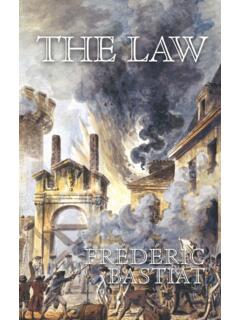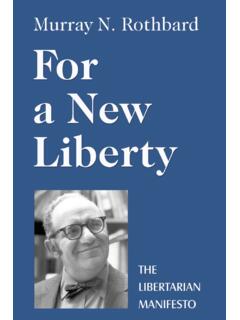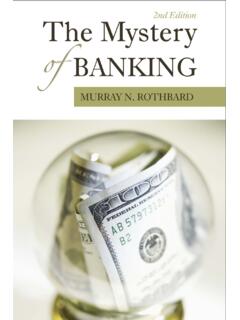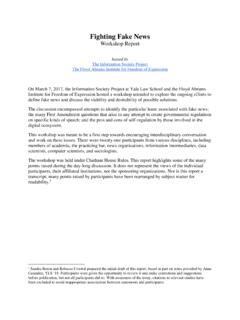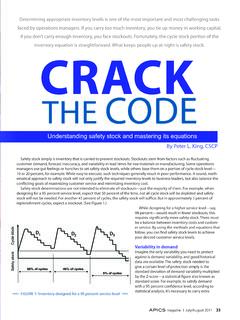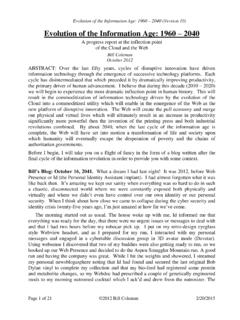Transcription of America's Great Depression - Mises Institute
1 America s Great DepressionFifth EditionINSTITUTEMISESA merica s Great DepressionFifth EditionMurray 1963, 1972 by Murray N. RothbardIntroduction to the Third Edition Copyright 1975 by Murray N. RothbardIntroduction to the Fourth Edition Copyright 1983 by Murray N. RothbardIntroduction to the Fifth Edition Copyright 2000 by TheLudwig von MisesInstituteCopyright 2000 by The Ludwig von Mises InstituteAll rights reserved. Printed in the United States of part of this book may be reproduced in any manner whatsoever withoutwritten permission except in the case of reprints in the context of reviews. Forinformation write The Ludwig von Mises Institute , 518 West Magnolia Avenue,Auburn, Alabama No.: 0-945466-05-6 TO JOEY,the indispensable frameworkThe Ludwig von MisesInstitute dedicates this volume to all of its generous donors, and in particular wishes to thank these Patrons:Dr. Gary G. Schlarbaum George N. Gallagher (In Memoriam), Mary Jacob, Hugh E. Ledbetter Mark M.
2 Adamo, Lloyd Alaback, Robert Blumen, Philip G. Brumder, Anthony Deden (Sage Capital Management, Inc.), Mr. and Mrs. Willard Fischer, Larry R. Gies, Mr. and Mrs. Hogan, Jr., Mr. and Mrs. William W. Massey, Jr., Ellice McDonald, Jr., MBE, Rosa Hayward McDonald, MBE, Richard McInnis, Mr. and Mrs. Roger Milliken (Milliken and Company), James M. Rodney, Sheldon Rose, Mr. and Mrs. Edward Schoppe, Jr., Mr. and Mrs. Robert E. Urie, Dr. Thomas L. Wenck Algernon Land Co., , J. Terry Anderson (Anderson Chemical Company),G. Douglas Collins, Jr., George Crispin, Lee A. Everhart, Douglas E. French,John William Galbraith, Walker S. Green, Mr. and Mrs. Max Hocutt, Donald L. Ifland, Joe R. Lee, Arthur L. Loeb, William R. Machgan, Dorothea H. Marica, Bernard Morton, Daniel W. Muirhead, James O Neill,Charles H. Reeves (Reeves Family Foundation), Donald Mosby Rembert,Stephen K. Salisbury, Mr. and Mrs. Allan Sawatzky, Joseph P. Schirrick, Mr. and Mrs. Thomas W. Singleton (Nehemiah Foundation), Robert W.
3 Smiley, Jr. (The Benefit Capital Companies), Byron L. Stoeser,Joseph J. Syslo, James E. Tempesta, , top dog , Alex T. Van Rensselaer,Lawrence Van Someren, Sr., Mr. and Mrs. Quinten E. Ward, David Westrate, Anne Williamson, Keith S. Wood Robert Bero, Robert J. Birnbach, Richard Bleiberg, John Hamilton Bolstad, Mr. and Mrs. Justin G. Bradburn, Jr., David and Elizabeth Butler, John W. Carpenter, Dr. John P. Cochran, John Cooke, Henry V. Curll,James V. De Santo (DTL Inc.), Chris A. Doose, Mr. and Mrs. Ted C. Earle, Jay Elliott, Eric Englund, Dr. Larry J. Eshelman, Lawrence N. Field, Elton B. Fox (The Fox Foundation), Capt. and Mrs. Maino des Granges,Christopher J. Hackett, John A. Halter, John R. Harper, Frank W. Heemstra,Douglas M. Joy, Michael G. Keller, , Robert N. Kennedy, Richard J. Kossmann, , David Kramer, Steven R. Krause, Gary R. Letsinger, Diana Lewis, J. Edward Martin, Norbert McLuckie, Samuel Mellos, Joseph Edward Paul Melville, Robert Mish, Dr. Dorothy Donnelley Moller, Jerry W.
4 Moore, Keith E. Moore, , Reed W. Mower, Brantley I. Newsom, Professor and Mrs. Stanley E. Porter, James A. Reichert, Thomas S. Ross,Conrad Schneiker, Roy Schroeder, William V. Stephens, Charles Toops, II (Mo-Ark Guide Service), Robert H. Walker (Walker Die Casting Company), Mr. and Mrs. Victor Zadikov, Jeannette Zummo IntroductionvviAmerica s Great DepressionAcknowledgments While the problem of 1929 has long been of interest tomyself as well as most Americans, my attention wasfirst specifically drawn to a study of the GreatDepression when Mr. Leonard E. Read, President of theFoundation for Economic Education, asked me, some years ago, toprepare a brief paper on the subject. I am very grateful to Mr. Readfor being, in this way, the sparkplug for the present book. Havingwritten the article, I allowed the subject to remain dormant forseveral years, amid the press of other work. At that point, on thewarm encouragement of Mr. Richard C.
5 Cornuelle, now of theFoundation for Voluntary Welfare, I proceeded on the task ofexpansion to the present work, an expansion so far-reaching as toleave few traces of the original sketch. I owe a particular debt tothe Earhart Foundation, without whose aid this study could neverhave been written. My supreme debt is to Professor Ludwig von Mises , whosemonumental theory of business cycles I have used to explain thecauses of the otherwise mysterious 1929 Depression . Of allProfessor Mises s notable contributions to economic science, hisbusiness cycle theory is certainly one of the most significant. It isno exaggeration to say that any study of business cycles not basedupon his theoretical foundation is bound to be a fruitless under-taking. The responsibility for this work, of course, is entirely my own. viIntroductionviiviiiAmerica s Great DepressionContents Introduction to the Fifth to the Fourth to the Third to the Second to the First I: business cycle THEORY1 THE POSITIVE THEORY OF THE cycles and business problem: the cluster of explanation: boom and features of Depression : deflationary credit Depression policy: in the Austrian theory of the trade KEYNESIAN CRITICISMS OF THE liquidity trap.
6 39 Wage rates and SOME ALTERNATIVE EXPLANATIONS OF Depression : A acceleration of investment opportunities ..68 Schumpeter s business cycle credit and II: THE INFLATIONARY BOOM: 1921 19294 THE INFLATIONARY definition of the money of the money supply, 1921 the inflation, I: reserve the inflation, II: total bought government THE DEVELOPMENT OF THE crisis THEORY AND INFLATION: ECONOMISTS AND THE LURE OF A STABLE PRICE : THE Great Depression : 1929 19337 PRELUDE TO Depression : MR. HOOVER AND development of Hoover s interventionism: development of Hoover s interventionism: labor THE Depression BEGINS: PRESIDENT HOOVER TAKES White House New Deal Farm Smoot Hawley in the second half of public works fiscal burdens of THE TRAGIC YEAR ..257 The American monetary fiscal burden of works and wage wage in the last quarter of spread of collectivist ideas in the business HOOVER NEW DEAL OF tax versus works inflation inflation Hoover s war on the stock home loan bank bankruptcy fight against CLOSE OF THE HOOVER attack on property rights: the final currency , hours, and employment during the : the lessons of Mr.
7 Hoover s : GOVERNMENT AND THE NATIONALPRODUCT, 1929 1: Total Money Supply of the United States, 1921 2: Total Dollars and Total Gold 3: Member Bank Demand 4: Demand and Time 5: Time 6: Member Bank Reserves and 7: Changes in Reserves and Causal Factors .. 1921 8: Per Month Changes in Reserves and Causal Factors .. 1921 9: Factors Determining Bank Reserves July October I: National II: Income Originating in III: Private IV: Government V: Expenditures of Government VI: Expenditures of Government and Government VII: Receipts of Government andGovernment VIII: Government and the Private s Great DepressionxiiAmerica s Great DepressionIntroduction to the Fifth EditionThe Wall Street collapse of September October 1929 andthe Great Depression which followed it were among themost important events of the twentieth century. Theymade the Second World War possible, though not inevitable, andby undermining confidence in the efficacy of the market and thecapitalist system, they helped to explain why the absurdly ineffi-cient and murderous system of Soviet communism survived for solong.
8 Indeed, it could be argued that the ultimate emotional andintellectual consequences of the Great Depression were not final-ly erased from the mind of humanity until the end of the 1980s,when the Soviet collectivist alternative to capitalism crumbled inhopeless ruin and the entire world accepted there was no substitutefor the the importance of these events, then, the failure of his-torians to explain either their magnitude or duration is one of thegreat mysteries of modern historiography. The Wall Street plungeitself was not remarkable, at any rate to begin with. The UnitedStates economy had expanded rapidly since the last downturn in1920, latterly with the inflationary assistance of the bankers andthe federal government. So a correction was due, indeed economy, in fact, ceased to expand in June, and it wasinevitable that this change in the real economy would be reflectedin the stock bull market effectively came to an end on September 3,1929, immediately the shrewder operators returned from vacationand looked hard at the underlying figures.
9 Later rises were merelyxiiIntroductionxiiihiccups in a steady downward trend. On Monday October 21, forthe first time, the ticker tape could not keep pace with the news offalls and never caught up. Margin calls had begun to go out bytelegram the Saturday before, and by the beginning of the weekspeculators began to realize they might lose their savings and eventheir homes. On Thursday, October 24, shares dropped verticallywith no one buying, and speculators were sold out as they failed torespond to margin calls. Then came Black Tuesday, October 29,and the first selling of sound stocks to raise desperately needed far all was explicable and might easily have been particular stock market corrective was bound to be severebecause of the unprecedented amount of speculation which WallStreet rules then permitted. In 1929 1,548,707 customers hadaccounts with America s 29 stock exchanges. In a population of 120million, nearly 30 million families had an active association withthe market, and a million investors could be called , of these nearly two-thirds, or 600,000, were trading onmargin; that is, on funds they either did not possess or could noteasily danger of this growth in margin trading was compoundedby the mushrooming of investment trusts which marked the lastphase of the bull market.
10 Traditionally, stocks were valued at aboutten times earnings. With high margin trading, earnings on shares,only one or two percent, were far less than the eight to ten percentinterest on loans used to buy them. This meant that any profitswere in capital gains alone. Thus, Radio Corporation of America,which had never paid a dividend at all, went from 85 to 410 pointsin 1928. By 1929, some stocks were selling at 50 times earnings. Amarket boom based entirely on capital gains is merely a form ofpyramid selling. By the end of 1928 the new investment trusts werecoming onto the market at the rate of one a day, and virtually allwere archetype inverted pyramids. They had high leverage anew term in 1929 through their own supposedly shrewd invest-ments, and secured phenomenal stock exchange growth on thebasis of a very small plinth of real growth. United FoundersCorporation, for instance, had been created by a bankruptcy withIntroduction to the Fifth Editionxivan investment of $500, and by 1929 its nominal resources, whichdetermined its share price, were listed as $686,165,000.

